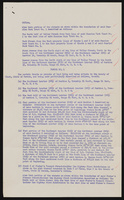Search the Special Collections and Archives Portal
Search Results
Kim Sisters Scrapbooks and Clippings
Identifier
Abstract
The Kim Sisters material date from 1959 to 1966 and 1983. It consists of two scrapbooks and one folder of photocopied materials containing newspaper clippings about the appearances of the Kim Sisters muscial group throughout the United States as well as Italy, Germany, and Spain. It also includes two record album sleeves.
Archival Collection
University of Nevada, Las Vegas Student Engagement and Diversity Records
Identifier
Abstract
The Student Engagement and Diversity Records (approximately 1989-2009) document activities related to the University of Nevada, Las Vegas (UNLV) Student Engagement and Diversity office and its predecessors. Materials include documents and photographs about activities and events such as Premier UNLV, Homecoming, Rebels After Dark, and the Rebel Variety Show.
Archival Collection
Margo Mansergh Papers
Identifier
Abstract
The Margo Mansergh Papers (approximately 1920-2010) document the life of former showgirl and dancer Margaret "Margo" Mansergh Tomaszewski. Materials include photographs of Margo modeling, backstage at various shows, portraits, and personal family photographs as well as programs from her international career performing in the Lido de Paris and Pigalle Nightclub in London, as well as a number of shows in Las Vegas, Nevada, such as Vive Les Girls, Casino de Paris, Minsky's Burlesque, and Lido de Paris at the Stardust. The collection contains materials from Mansergh's modeling career, including photographs, book covers, and images of her as an extra in films. Digital images from the closing Stardust performance and an event for Miss Bluebell are also found in the collection.
Archival Collection
Dr. Ruben Acherman oral history interview
Identifier
Abstract
Oral history interview with Ruben Acherman conducted by Monserrath Hernandez and Laurents Bañuelos-Benítez on July 18, 2019 for the Latinx Voices of Southern Nevada Oral History Project. In this interview, Acherman discusses growing up in Palmira, Colombia, where his father emigrated to from Romania. He talks about how accepted he felt in a Catholic community, moving to Cali, Colombia to study medicine, and describes completing his rural residency in San Pedro, Colombia. Acherman then recalls specializing in cardiology at the University of Southern California (USC). Later, Acherman explains why he chose to specialize in cardiology, his interests in pediatric cardiology, and his inability to continue studying due to the lack of financial stability and his immigration status. Acherman describes his move to the Summerlin residential community in Las Vegas, Nevada after being offered a position to work for Dr. Bill Evans in 2001, and compares the differences in health care between the United States and Columbia. Lastly, Acherman discusses his first balloon dilation procedure and talks about the illustrations he has created in cardiology textbooks.
Archival Collection
Richard W. Bunker oral history interviews
Identifier
Abstract
Oral history interviews with Richard W. Bunker conducted by Stefani Evans and Claytee D. White on July 18 2017, July 21, 2017, and September 28, 2017 for the Building Las Vegas Oral History Project. In this interview, Bunker discusses the history behind a wide range of events that affected the daily lives of Southern Nevadans. He talks about his role in a consolidation attempt between the Clark County and Las Vegas, Nevada governmental structures that was halted by the courts in 1975. Bunker then recalls working as a member and Chair of the Nevada Gaming Control Board and his work with various casinos and hotels including Circus Circus, the Dunes, and the Aladdin. He discusses replacing key people at the Gaming Control Board, and the Federal Bureau of Investigation’s (FBI) Operation Yobo sting. He then speaks fondly of his longtime friends Jim Gibson, Judge Lloyd George, and Jim Joyce. Lastly, Bunker discusses water rights, supply, and management issues in Nevada as it relates to the Nevada Resort Association, Las Vegas Valley Water District, Southern Nevada Water Authority, and the Colorado River Commission.
Archival Collection

Hernando Amaya oral history interview: transcript
Date
Archival Collection
Description
Oral history interview with Hernando Amaya conducted by Laurents Banuelos-Benitez, Marcela Rodriguez-Campo, and Barbara Tabach on October 18, 2018 and December 3, 2018 for the Latinx Voices of Southern Nevada Oral History Project. In this interview, Hernando Amaya talks about his childhood and education in Bogota, Colombia. He discusses his start in journalism as a young man and working for El Espectador, the Colombian national newspaper. He discusses his experiences reporting on the narco-terrorism occurring in Medellin, Colombia and how this eventually led to his immigration to the United States. Amaya moved to Las Vegas, Nevada in 2001 and continued his career in journalism by working for local Spanish speaking papers and websites. He relates his civic involvement in the Las Vegas area, his work as the president of the Colombian Association of Las Vegas, and various other civic engagements. As a journalist, he asserts the importance of knowing one's culture, storytelling, learning history, and being active in the community.
Text
Jacob E. Von Tobel Photograph Collection
Identifier
Abstract
The Jacob E. Von Tobel Photograph Collection contains black-and-white photographs of the pioneer Von Tobel family from 1900 to 1980. The collection includes photographs of the Von Tobel family, early Las Vegas, Nevada buildings and landmarks, and aerial photographs of Las Vegas and surrounding areas.
Archival Collection
Alice P. Broudy Papers on Broudy v. United States
Identifier
Abstract
The Alice P. Broudy Papers on Broudy v United States (1940-2018) comprise materials collected and created by the wife of Charles A. Broudy during her effort to obtain compensation for his death in 1977, which she believed to be a result of repeated radiation exposure. Materials include government documents obtained through the Freedom of Information Act (FOIA), correspondence, memos, litigation papers, scholarly reports and articles on radiation exposure and its effects, congressional testimony, speeches, newspaper clippings, books and audiovisual materials. Also included are photographs, slides, and one box of Alice "Pat" Broudy's personal papers. There are two boxes of papers that remain unprocessed.
Archival Collection


